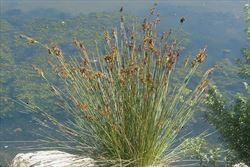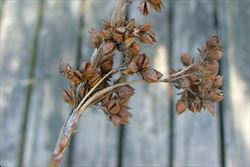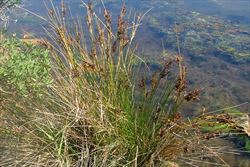Click on images to enlarge

infestation (Photo: Sheldon Navie)

habit (Photo: Sheldon Navie)

habit (Photo: Sheldon Navie)

close-up of stems and leaves (Photo: Sheldon Navie)

the tip of a flowering stem, which tapers into a very sharp spine (Photo: Sheldon Navie)

flower buds (Photo: Sheldon Navie)

flowers (Photo: Jackie Miles and Max Campbell)

immature fruit (Photo: Sheldon Navie)

close-up of mature fruit (Photo: Sheldon Navie)

sea rush, Juncus kraussii subsp. australiensis (Photo: Sheldon Navie)
Scientific Name
Juncus acutus L. subsp. acutus
Synonyms
Juncus acutus L.
Family
Juncaceae
Common Names
cultivation rush, sharp pointed rush, sharp rush, sharp-pointed rush, spiny rush, sharp sea rush
Origin
The exact origin of this species is obscure, but this subspecies is thought to be native to the Mediterranean region and western Europe.
Naturalised Distribution
Widely naturalised in southern Australia. It is common and widespread in eastern and southern New South Wales, the ACT, Victoria, south-eastern South Australia and south-western Western Australia. Occasionally naturalised in other parts of South Australia, in Tasmania and in the southern parts of the Northern Territory. It has also recently become sparingly naturalised in south-eastern Queensland.
Habitat
A weed of moist habitats in temperate regions, including pastures, waterways, swamps, marshes, wetland areas, disturbed sites, waste areas and coastal environs.
Habit
An upright (i.e. erect) and long-lived (i.e. perennial) plant that is grass-like in appearance and eventually forms large tussocks. It usually grows 1-1.2 m tall, but may occasionally reach up to 2 m in height.
Distinguishing Features
- an upright and tufted long-lived plant that is grass-like in appearance and usually grows 1-1.2 m tall.
- its numerous unbranched stems bear a dense cluster of flowers just below their tip, which tapers into a sharp spine.
- its leaves are very similar to the stems, except that they do not bear flowers.
- its flowers are green, brown or reddish-brown in colour.
- its reddish-brown capsules (5-6 mm long).
Stems and Leaves
The numerous upright (i.e. erect) stems are produced off very short creeping underground stems (i.e. rhizomes). These upright stems (2-5 mm diameter) are unbranched, rounded in cross-section (i.e. cylindrical) and hairless (i.e. glabrous). They bear a dense cluster of flowers just below their tips, which taper into a very sharp spine.
The leaves are very similar in appearance to the stems, except that they do not bear flowers near their tips. They are also produced from the short creeping underground stems (i.e. rhizomes) at the base of the plant.
Flowers and Fruit
The flowers are either greenish, brown or reddish-brown in colour depending on their age. They are borne in dense branching clusters about 4-13 cm long and 3 cm wide. These clusters are made up of 5-50 smaller clusters, each containing 1-6 flowers. At the base of these flowers clusters there are usually one or two leafy bracts (4-25 cm long). Individual flowers are inconspicuous and almost stalkless (i.e. sessile or sub-sessile). They consist of three 'sepals' (i.e. outer tepals) and three 'petals' (i.e. inner tepals). These tepals are small (2-4 mm long) and often have narrow whitish margins near their tips. The flowers also have six small stamens and a three-celled ovary. Flowering occurs throughout the year, but mostly during spring and summer.
The fruit is a yellowish-brown to chestnut-brown capsule (5-6 mm long) that is egg-shaped (i.e. ovoid) but with a pointed tip (i.e. acute apex). Each capsule contains many oval (i.e. ellipsoid) or irregularly shaped seeds (1.2-2 mm long). These seeds are brown in colour and have a membranous tail at either end.
Reproduction and Dispersal
This species reproduces mostly by seed, but also spreads vegetatively via the short, creeping, underground stems (i.e. rhizomes).
Seeds are dispersed in mud and contaminated agricultural produce and also by water, vehicles and machinery. The rhizomes may be spread during cultivation, road maintenance and other soil moving activities.
Environmental Impact
Spiny rush (Juncus acutus subsp. acutus) is regarded as a very serious environmental weed in Victoria and New South Wales, an environmental weed of some importance in South australia and Western Australia, and as a minor or potential environmental weed in southern Queensland and the southern parts of the Northern Territory. It was recently listed as a priority environmental weed in two Natural Resource Management regions.
Other Impacts
This species can eliminate all useful pasture species in infested areas, and as it is not readily eaten by grazing animals, it may significantly reduce the productivity of pastures. Because of its sharp spines, stands of spiny rush (Juncus acutus subsp. acutus) can also become impenetrable to livestock and humans, preventing access to water. The sharp spines, can also cause injury to animals, livestock and humans.
Infestations can provide habitat for smaller pest animals, and when growing in drains and channels spiny rush (Juncus acutus subsp. acutus) can seriously obstruct water flow, causing flooding.
Legislation
This species is declared under legislation in the following states and territories:
- Victoria: P1 - prohibited and must be eradicated or controlled (in the East Gippsland region only), and C9 - all reasonable steps must be taken to control the weed and prevent its spread (in the Mallee, Wimmera, Glenelg, North Central, Corangamite, Port Phillip West, Goulburn, North East and West Gippsland regions). For more information see the Victorian Department of Sustainability and Environment Pest Plant Note on this species.
- Western Australia: Unassessed - this species is declared in other states or territories and is prohibited until assessed via a weed risk assessment (throughout the entire state).
Management
For information on the management of this species see the following resources:
- the Victorian Department of Primary Industries Landcare Note on this species, which are both available online at http://www.dpi.vic.gov.au.
Similar Species
Spiny rush (Juncus acutus subsp. acutus) is very similar to the native sea rush (Juncus kraussii subsp. australiensis). These two species can be distinguished by the following differences:
- spiny rush (Juncus acutus subsp. acutus) grows in both coastal and inland areas and its stems end in very sharp rigid points. Its relatively large capsules (5-6 mm long) are somewhat longer than the remnant floral parts and turn golden-brown to chestnut-brown when mature. They contain several relatively large seeds (1.3-1.8 mm long) with small projections at both ends.
- sea rush (Juncus kraussii subsp. australiensis) only grows in coastal habitats and while its stems end in sharp points they are not very rigid. Its relatively small capsules (2.5-3 mm long) are about as long as the remnant floral parts and turn golden-brown to blackish when mature. They contain several relatively small seeds (0.5-1 mm long) without any projections.
Spiny rush (Juncus acutus subsp. acutus) is also similar to many other rushes (Juncus spp.) and also some sedges (Cyperus spp. and Carex spp.). There are too many species to mention, however spiny rush (Juncus acutus subsp. acutus) can usually be distinguished from these by its very sharply pointed stems and leaves.

